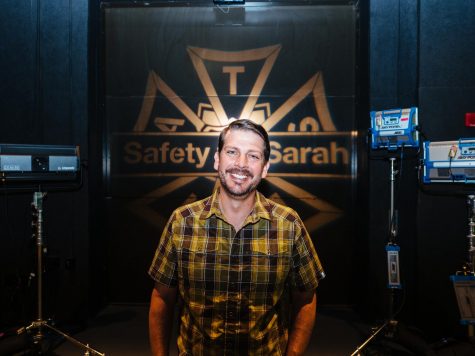New cinema grant offered for seniors
Sarah Jones Foundation emphasizes safety on film sets
September 11, 2019

Cinema Safety Coordinator Terry Shirk poses in front of a Safety for Sarah light that shines on a wall in the soundstage of the Playhouse.
Every year, Cinema Department Safety Coordinator Terry Shirk adds to and tweaks the student filmmaking handbook. This year, he was able to include information regarding a new $2,500 grant opportunity that senior film students can apply for.
However, the opportunity is the result of an instance of filmmaking gone wrong.
On Feb. 20, 2014, tragedy struck on the set of “Midnight Rider,” an indie film directed by Randall Miller. The set was on a CSX-owned railway bridge just outside of Doctortown, Ga. The film crew did not have permission to shoot there.
When a train suddenly made its way across the bridge, Sarah Jones, 27, a camera assistant for the film, was struck and killed.
Her death marked the beginning of Safety for Sarah, which started as a social media movement but has since gone on to become the Safety for Sarah Jones Film Foundation.
The foundation, which was started by Sarah’s parents, Richard Jones and Elizabeth McCartha Jones, partners with higher education institutions through its Sarah Jones Safety Grant Program. This year, Point Park joined the list of partners.
“We met over the summer via phone,” Shirk said. “I sent them a copy of the handbook and talked to them about how we take safety very seriously and discussed how students plan to make good decisions and how I monitor them and this handbook. And they decided that we would make a good partner.”
The grant will be awarded annually to any senior film student working on their thesis, or P4 level film. Students who win the grant will put the funds towards on-set safety measures.
The grant and partnership is the newest addition to the Cinema Department’s relatively recent focus on safety. And according to Shirk, his position of Safety Coordinator is not common at the university level.
“It’s unique that Point Park is one of a handful of universities that has a dedicated safety coordinator for their film program,” Shirk said. “That doesn’t mean other programs don’t take it seriously, but Point Park decided to create a position focused solely on overseeing the safety of student production work.”
Shirk has been in his position at Point Park for the past five years, following a program review by Emerson College, where its main suggestion was to hire staff to focus solely on student safety for the department.
“Every year we have a huge safety presentation done by Terry,” Kate Griffith, a sophomore cinema production major said. “It’s going over everything, the rules of the road of what not to do on set. There’s new rules every year. We have to think about, locations, electrical work, weather…everything and anything that can go wrong on a set. They want to make sure that you’re safe every time you’re on set.”
The Sarah Jones tragedy is just one example of safety errors that film students are made aware of in class.
“In the case of Sarah, someone decided to film where they weren’t allowed to and someone was tragically killed because of it,” Griffith said. “And even on the Mister Rogers movie set, someone fell off a balcony and died, due to exhaustion. Safety is something that we have to recognize and accept in the industry if we’re going to move forward…Sarah is a big example we talk about in class, but there are dozens more.”
Senior cinema production major, Kelly Tran, only learned about the Safety for Sarah grant this semester through a Facebook post, but according to Tran, she’s known Sarah’s story since her freshman year of school.
Tran plans to apply for the grant this year in order to fund safety measures on the set of her senior thesis film, “Emily Has a Body”. Tran is currently in pre-production and is in the process of raising $8,000 for the film.
The film, which is about a thirteen year old girl named Emily, features scenes in a car and where the main character’s hair catches on fire.
“Obviously there are some things to be cautious about especially with the fire, and we aren’t going to really set her hair on fire,’” Tran said. “We are going to try and make it as realistic as possible while making our talent safe and protected. We have a scene in a car, but Point Park doesn’t let us shoot in a car, so we will use a green screen. We want our actors to be in the best space they can be in, so my top priority is making everyone feel safe and happy.”
In order to keep her actors safe, she will have to hire effects artists, Tran said. The grant would be put towards paying them.
“We would hire an effects artists for the fire and for the green screen,” Tran said. “And we would use the money for a space to bring the vehicle in and execute the scene properly.”
For senior thesis students like Tran looking to apply for the grant, details on how to do so are listed on page 35 of the student filmmaker’s handbook, curated by Shirk. According to Shirk, he plans to review applications in October and meet with a faculty committee to narrow down the top three candidates and work with the Sarah Jones Film Foundation to award a winner in December.
For underclassmen, the grant will be available to them for their senior projects. However, safety on set is always a topic that students must be mindful of, which is due in part to the work of Shirk and the rest of the department.
“The goal in any type of film is that everyone should be able to go home at the end of the day and be okay,” Griffith said.
















